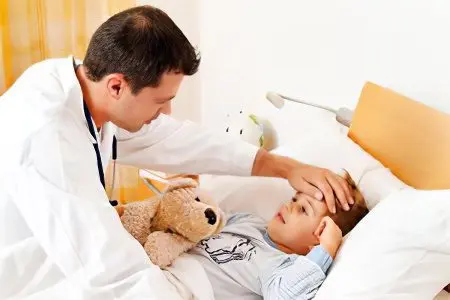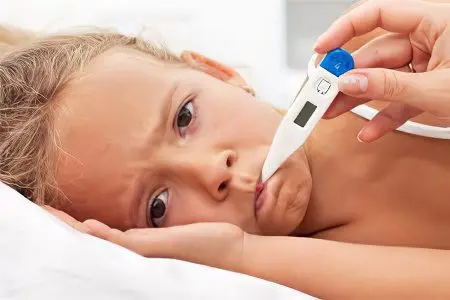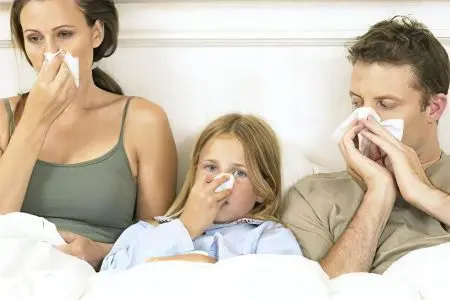Contents

Influenza in children – This is an acute infectious disease that is provoked by the penetration of influenza viruses types A, C and B into the cells. The disease is accompanied by damage to the respiratory organs, intoxication of the body and often causes various complications.
According to statistics, every year the influenza virus affects up to 30% of the entire population of the globe, while 15% of them are children of primary preschool and school age. Children between the ages of 3 and 14 are most susceptible to the influenza virus. In the high-risk group, young children, in whom SARS account for up to 65% of the total morbidity.
Adults, compared to children, are more resistant to infection because their immune systems function better. Children get sick 4-5 times more often.
The main danger of infection is that it is often complicated by various pathologies and exacerbates existing chronic diseases. In this regard, in pediatric practice, the issue of prevention and treatment of influenza is acute.
flu symptoms in children
The virus, once in the body of a child, may not give itself away for several hours, up to 4 days.
After this time, flu symptoms increase in children, which, with a typical development of the disease, are expressed as follows:
Acute onset, accompanied by an increase in body temperature up to 40 ° C. In this case, the symptoms of intoxication of the body will prevail over other manifestations of the disease. In infants, fever is often the only sign of the virus entering the body. From one to five years, in addition to an increase in body temperature, it is possible to add cough and runny nose. After the age of five, fever is accompanied by lachrymation, sweating, chills, sore throat, coryza, and dry cough.
Children of any age refuse to eat, or their appetite deteriorates significantly.
Lethargy grows, the child becomes inactive. Older children may complain of headaches, joint and muscle pain. The occurrence of repeated vomiting is not ruled out.
Children are more likely than adults to develop nosebleeds. Against the background of hemorrhagic syndrome, pitechiae on the skin, hemorrhages on the mucous membranes, and on the eye sclera may appear. This symptom indicates a special degree of severity of the course of the disease.
At the peak of fever in children under one year old, seizures may develop, and at an older age, impaired consciousness, hallucinations and delirium are not excluded.
The skin integuments in children are pale, and in infancy, a marble pattern may appear. In this case, the cheeks often become crimson in color.
The stronger the fever, the more pronounced the tachycardia will be.
It is not excluded the development of abdominal syndrome, manifested by painful sensations in the intestinal region.
Most children suffer from rhinitis, while the discharge from the nose is serous-mucous in nature.
The soft palate is edematous, the back wall of the oropharynx is hyperemic, there is abundant granularity. It is possible to develop tracheitis with a dry cough, which causes pain not only along the trachea, but also behind the sternum.
An improvement in the child’s condition will occur on the 3-4th day if the flu has a mild or moderate course. However, one should not expect a complete recovery after such a short period of time. Such phenomena as a runny nose, sore throat, cough will continue for another 14 days. The recovery period after influenza in children is accompanied by increased fatigue, excessive sweating and weakness.
The high-risk group includes newborns and children under six months of age. The manifestations of toxicosis in them are minimal, the development of the disease is gradual, catarrhal phenomena are often absent. Children refuse to eat, spit up, sometimes vomiting develops, sleep is disturbed. Bacterial complications develop very early and quickly, in connection with this, the outcome of the disease can be unfavorable.
Causes of flu in children

The causes of influenza in children are infection of the body with a virus belonging to the family of orthomyxoviruses. It can be a virus of type A, B or C. Due to the fact that type A virus is capable of variability in its own structure, it is he who causes epidemics more often than other viruses. The source of infection is either an infected person or another living organism (birds and pigs).
As for influenza type B, it is he who most often affects children, circulating only among people. Mass cases of infection registration most often occur before the outbreak of influenza type A, or are combined with it. Type B influenza epidemics usually occur within a single country.
Influenza type C virus causes isolated cases of the disease and has a stable structure, therefore, influenza vaccine strains do not contain it.
Children are infected mainly by airborne droplets during a conversation, coughing, sneezing. Although in organized children’s groups, the contact-household way of transmitting the disease is not uncommon. The virus can be on the surfaces of personal care products, toys, cutlery, bed linen, etc.
The virus spreads especially actively under changing weather conditions with fluctuations in humidity and ambient temperature.
Other conditions favorable for the transmission and infection of the influenza virus are:
Hypovitaminosis, which is often found in children;
Lack of sunlight;
Lack of full-fledged immune protection;
Crowding of children’s groups;
Unformed hygiene skills in children or insufficient hygiene.
The virus infection process is as follows:
The infection enters the child’s body through the ENT organs and is fixed in the epithelium of the respiratory tract;
Having attached to the cell with the help of hemagglutinin, the virus begins to destroy the integrity of the cell membrane;
Once inside the cell, the virus starts producing its proteins and RNA;
New viruses leave the destroyed cell and look for a healthy one in order to continue the process of reproduction;
Having destroyed the epithelium of the respiratory tract, the viruses enter the bloodstream and spread throughout the child’s body, provoking intoxication.
Complications of influenza in children
Complications of influenza in children can vary in time (late and early), by etiological factor (viral and bacterial), and also by location.
Most often in childhood against the background of the flu, a complication such as pneumonia develops. Primary viral pneumonia occurs in the first 1-2 days and most often has a hemorrhagic character. It is possible to develop a distress syndrome with severe respiratory failure, sputum with blood, wheezing in the lungs. Against the background of such a complication, a lethal outcome is not excluded, which occurs 4-5 days from the onset of pneumonia.
Secondary bacterial pneumonia develops more often on the 5-6th day from the onset of the underlying disease. It can be provoked by staphylococci, pneumococci, Haemophilus influenzae, chlamydia, legionella and other bacteria.
In addition to pneumonia, the following complications of infection are possible:
False croup;
otitis media;
Bronchiolitis;
Sinusitis;
Myositis;
mmiocarditis;
Meningoencephalitis;
Liver and kidney damage is more common in avian influenza;
Reye’s syndrome;
Renal failure;
Cardiovascular insufficiency;
Stenosis of the larynx;
asthmatic syndrome.
Children under 2 years old are more susceptible to complications, as well as those patients who have other concomitant diseases: heart defects, bronchial asthma, congenital immunodeficiency, diabetes, etc.
Popular Parent Questions

Is it possible to bathe a child with a cold? Many parents have known since childhood that it is forbidden to bathe a child with a cold. In fact, the child needs to be washed, and the ban on bathing during illness goes back to past centuries, when a trough was required for hygiene procedures, and there was no hot water in the house. But if the child’s body temperature is elevated, then you should not bathe him in a hot bath. A warm shower is the best solution.
How to understand that the child has recovered? If the body temperature remains normal for three days, if the dry cough turns into a wet one and does not acquire a yellow or green tint, then we can talk about a positive trend. In the event that the body temperature rises again, then you should be especially wary, as this is a bad symptom indicating the development of complications.
If a child is sick, should he eat better? The food that the child takes should be light and contain a maximum of carbohydrates and vitamins. The fact is that for the breakdown of protein products, the body needs a lot of strength, which should be directed primarily to fighting the infection. After the fever is over, you need to feed the recovering child tightly, which will allow you to restore the spent strength.
Treatment of influenza in children
Influenza treatment in children is most often done at home. However, if there are indications (severe course of the disease, complications of infection), the patient must be hospitalized. In addition, all newborns and infants are hospitalized. Social indications for inpatient treatment should be taken into account, for example, the presence of a child in an orphanage, or living in an asocial family.
Basic principles of therapy for children with influenza:
Rest in bed during the acute period of the illness and semi-bed rest while the fever is over.
Light but balanced diet, drink plenty of water.
At the discretion of the attending doctor, antiviral drugs are prescribed: Ingavirin, Tamiflu, IRS 19, Remantadin, Arbidol, Grippferon, Amixin, Kagocel, etc.
Taking antipyretic drugs at a body temperature above 38,6 ° C. Children should be given either paracetamol or ibuprofen to lower body temperature. Acetylsalicylic acid is not prescribed for children.
With viscous and thick sputum, it is necessary to take mucolytic drugs, for example, Ambroxol, Erespal, Lazolvan and Bromhexine. According to indications, inhalations are carried out with sputum thinning solutions.
When the cough is painful, it is possible to take antitussives, but not to suppress it, but to reduce the intensity of the cough. It can be such means as: Tusupreks, Libeksin, Sinekod, Glauvent.
Vasoconstrictor drops are instilled into the nose at an age-appropriate dosage, for example, Tizin, Nazivin, Rinofluimucil, etc.
It is possible to take B vitamins, vitamin C, or multivitamin complexes.
Antibiotics are prescribed for the development of bacterial complications. For this, the following drugs can be used:
Protected penicillins: Amoxiclav, Flemoxin solutab, Augmentin;
Cephalosporins: Ceftriaxone, Cefuroxime Axetil;
Macrolides: Azithromycin, Roxihexal, Vilprafen, etc.
During the recovery period, it is possible to take adaptogens and immunomodulators.
How not to treat influenza and SARS in children
Some world statistics

It has been proven that up to 90% of all SARS that occur in childhood are of viral origin. Antibacterial therapy has no effect on viruses. However, many parents, due to their ignorance, and also wanting to speed up recovery, give their child antibiotics for every cold.
It should be understood that there are no safe drugs. This also applies to antibacterial drugs that have a detrimental effect on the immune system, provoke dysbacteriosis, lead to the development of allergies, “harden” bacteria, increasing their resistance.
Naturally, pediatricians are aware of the dangers of inadequate antibiotic therapy, but continue to prescribe it even with SARS. Indeed, in the conditions of a home examination, with little experience, when only a phonendoscope is in the hands, it is rather problematic to differentiate pneumonia from a cold.
The antibiotic is the easiest to prescribe. After all, the harm from taking these drugs is not very noticeable at the beginning of treatment, and if pneumonia still manifests, the doctor will say that he prescribed adequate treatment.
So, antibiotics for colds in children under 12 years of age should not be taken in the first five days from the onset of the disease. If parents are very worried about the adequacy of the therapy, then a blood and urine test should be done, an x-ray of the lungs should be taken to confirm the viral nature of the disease and exclude the development of complications.
Increased body temperature
Children aged 6 years and older should have their body temperature lowered if it exceeds 39°C or more. It can cause damage to the health of the child, as it goes beyond the boundaries of the physiological norm.
At the age of 6 years, body temperature must be reduced when it exceeds 38,6 ° C, as there is a risk of seizures. In the event that convulsions have occurred before, it is necessary to give an antipyretic at a body temperature of 37,5 ° C and above.
To reduce body temperature, you can use the following tips:
When the skin of the child is pink, it should not be additionally warmed. The child must be undressed to allow air to enter the body.
If the skin of the child is pale, then he should be covered with a light blanket and offered a plentiful warm drink.
Local rubbing of the legs and arms of a child with vodka can be done only after a year. Alcohol, evaporating, will cool the skin. Do not use stronger alcohol solutions, as this can injure delicate baby skin. In addition, some of the alcohol will be absorbed, which will contribute to intoxication.
Cold should be applied to the main vessels. To do this, you should fill the bottle with cold water and apply it to the inguinal zone and to the armpits, since it is there that large blood vessels pass.
The head of the child should remain open, since up to 80% of heat loss occurs through it.
The child should consume as much liquid as possible, since during a fever it evaporates very intensively. This threatens with dehydration.
Prevention of influenza in children is carried out primarily through vaccination. Their effectiveness has been proven by many years of testing and experience of use. This is the main measure of protection against the influenza virus, which is recommended by WHO. Immunity is developed approximately one month after the introduction of the vaccine and will last on average for a year. For this purpose, children are given vaccines such as Influvac, Grippol, Grippol plus, Fluarix, etc.
Other preventive measures to prevent the incidence of influenza in children are the following actions:
Early detection of the disease and isolation of a sick child from society.
Systematic ventilation of the premises and their regular wet cleaning using disinfectants.
Room quartzing.
Frequent hand washing.
Wearing sterile medical masks during the epidemic.
Refusal to visit crowded places.
Refusal of intergroup and other mass events in kindergarten.
The introduction of extraordinary holidays during the influenza epidemic.
As a rule, the prognosis for recovery is favorable in the case of a typical course of the disease. The threat of death increases with hypertensive and complicated forms of influenza, as well as with infection of children at risk.









